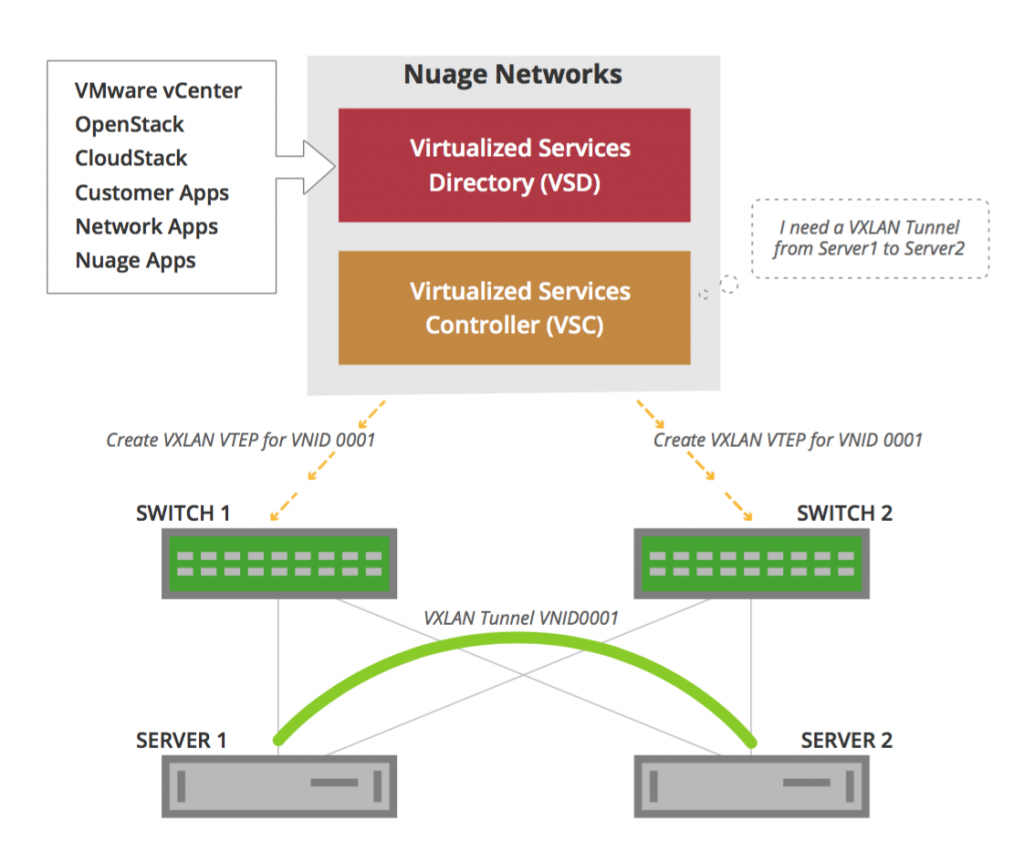Nuage Networks is announcing an exciting new product integration with Cumulus Networks, a leading cloud networking vendor with a Linux network operating system (Cumulus Linux) that runs on white box switching hardware. With over one million ports in production, Cumulus Networks helps organizations of all sizes realize the promise of the SDN-enabled datacenter by enabling high-capacity networks that are easy to deploy and scale affordably. Cumulus Networks offers hardware-accelerated Linux networking that supports layer 2, layer 3 and overlay networking, and forms an alternative to generally higher-cost, proprietary networking appliances.
Within the Nuage VSP environment, Cumulus Linux switches act like any physical top of rack switch, including serving as a VXLAN tunnel end-points (VTEP) for physical workloads, or as VTEP gateways to WAN networks. When acting as a WAN gateway from the Nuage Network VXLAN overlay environment, Cumulus Linux performs the VXLAN-to-VLAN mappings required for integration with traditional (non-overlay) networks.
The combined Nuage and Cumulus Linux networking infrastructure, spanning both physical and virtual networks and workloads, is orchestrated under a single SDN controller, the Nuage Virtual Services Controller (VSC), and a single cloud networking policy model. As is the case with all Nuage networks, the combined Nuage-Cumulus Linux network can be orchestrated in OpenStack or CloudStack cloud management systems through the Nuage SDN platform.
The integration of a Cumulus Networks infrastructure into the Nuage VSP follows this general scenario:
- Configure the Nuage Networks VSC to control the Cumulus Networks switches. VSC serves as the network control plane of the data center.
- The Nuage Networks Virtualized Services Directory (VSD) is now Cumulus Linux-aware. It discovers the enabled Cumulus Linux switches, assigns permissions, and configures VXLANs (including VXLAN to VLAN mappings in the case of VXLAN gateways). The VSD also serves as the SDN policy repository and business logic engine for the network.
- The VSD sends service information to the VSC and the Cumulus Linux switch (via OVSDB). The VSD is automatically aware of new hosts, MAC addresses, and new endpoints (VMs or VTEPs), based on VM events from VMware vCenter or another server virtualization or cloud management platform.
- The VSC sends VXLAN service attributes to the Cumulus Linux switch, so the switch is now configured. Port VLANs are now mapped to the VXLAN Virtual Network ID (VNID) as well as a list of available tunnels.

The Nuage centralized policy manager and controller (VSD and VSC) automate the configuration of Cumulus Linux switches to support VXLAN tunnels and gateways for physical networks and workloads.
When deployed in conjunction with Nuage Networks VSP, each Cumulus Linux layer 2 hardware VTEP automatically registers with the Nuage Networks VSD for simplified, single-click configuration. Once configured, users can then select physical ports, VLANs, or a combination of the two to become part of a tenant network. The VSP automatically learns the presence of such entities and manages the mapping of VTEP IP addresses to layer 2 workload addresses in order to eliminate multicast, while Cumulus Linux automatically handles the termination in hardware of the VXLAN tunnels for bare metal applications and gateways.
The emergence of cloud architectures has benefited greatly from the rapid adoption of virtual networking technologies, standards, and SDN automation platforms. But many cloud solutions need to satisfy the requirements of existing applications, running on bare metal servers and requiring hardware-accelerated performance. The reach of overlay networking thus needs to be extended to satisfy these requirements with integrated support for bare metal applications and VXLAN termination offloading for the best possible performance. Together, Cumulus Networks and Nuage Networks deliver on this common vision, integrating cloud architectures with legacy application environments and networks, managed under a common SDN controller, for an open, flexible, cost-effective IT automation solution.
More info: Nuage Networks Virtualized Services Platform (VSP) with Cumulus Networks solution overview

